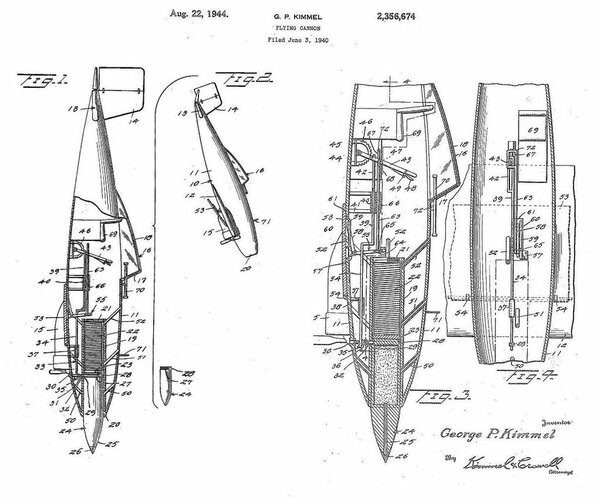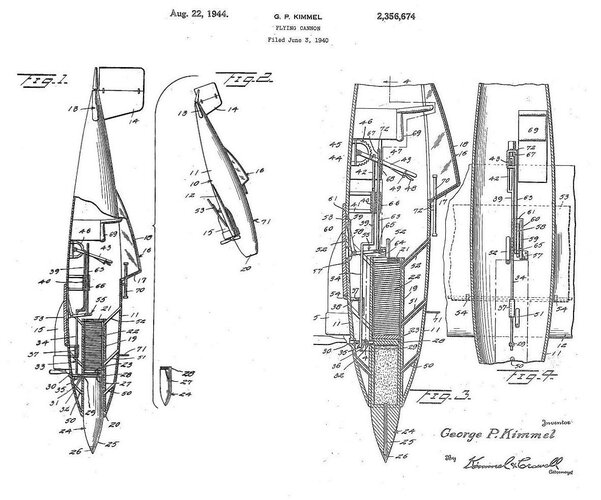You are using an out of date browser. It may not display this or other websites correctly.
You should upgrade or use an alternative browser.
You should upgrade or use an alternative browser.
kimmel flying canon 1940.
- Thread starter klem
- Start date
Dilandu
I'm dissatisfied, which means, I exist.
The best part of it - it's SPRING-LOADED flying cannon) No, really. It used the power of compressed spring to hurl projectile out of barrel, while plane is diving on target (a special lever mechanism would get the plane out of dive after shot).
- Joined
- 19 July 2016
- Messages
- 3,728
- Reaction score
- 2,694
Is that some kind of glider?
On the second graph, you can see that it was meant to have two engines on the wings. Actually, I think it wasn’t really a canon but much more a conventional dive bomber. If you see it this way, the idea is not entirely stupid, the bomb in the front would help to aim the target and reduce drag during the flight. The spring is needed to relive the bomb und not to collide with it afterwards, but surly not to increase the impact significantly.
What I find problematic it the CG shift when the bomb is relieved, there have been good reasons to mount the bombs under the fuselage with a neutral CG position. To make the concept work, the bomb should be much aft in the current position of the spring. To make room and to save some weight, the spring could be replaced by pressurized air reservoir which could blow out the bomb pneumatically instead with mechanical force.
What I find problematic it the CG shift when the bomb is relieved, there have been good reasons to mount the bombs under the fuselage with a neutral CG position. To make the concept work, the bomb should be much aft in the current position of the spring. To make room and to save some weight, the spring could be replaced by pressurized air reservoir which could blow out the bomb pneumatically instead with mechanical force.
- Joined
- 19 July 2016
- Messages
- 3,728
- Reaction score
- 2,694
It would also need to find a method of restoring the areodynamic balance post release. That hole in the front would be like an air brake elsewise.
I dont think so, a hole right in the front of a circular boby will cause some turbulence but not be highly proplematic. The early P51 or the P51 prototypes had variable entry geometry for the cooler, which was later found to be unessecay. So openings which are rectangular to the flight direction aren"t that bad. As long as there is no airflow, this hole would have been filled with pressurized air from the ram effect and the streamlines will be guided around it.
One point I miss in this concept, the bombs would have needed some stabilisation fins to hit the target prececily, which could have been done with a folding mechanism.
One point I miss in this concept, the bombs would have needed some stabilisation fins to hit the target prececily, which could have been done with a folding mechanism.
Dilandu
I'm dissatisfied, which means, I exist.
It's a twin-engine attack plane (and also heavy fighter), armed with approximately 16-inch spring-loaded gun. I'm not kidding. Author assumed that his contraption would attack warships from the dive, and spring would hurl the shell forward fast enough to guarantee a precise hit from 300-1000 feets. Author even suggested a crude lever mechanism to automatically move elevators after shell release.Is that some kind of glider?
Author actually thought about it. There are air ducts coming out of the barrel (number 51-52 on scheme).It would also need to find a method of restoring the areodynamic balance post release. That hole in the front would be like an air brake elsewise.
It's not a bomb. It's a heavy artillery shell of "standard type' (i.e. from large naval gun), launched from spring-loaded tube.One point I miss in this concept, the bombs would have needed some stabilisation fins to hit the target prececily, which could have been done with a folding mechanism.
- Joined
- 13 August 2007
- Messages
- 7,149
- Reaction score
- 6,522
i thought the 50 mm cannon in Me 262 was insane
but this here is more insane
looking on Patent i wonder what explode first on firing that contraption, canon or the plane it self ?
but this here is more insane
looking on Patent i wonder what explode first on firing that contraption, canon or the plane it self ?
- Joined
- 19 July 2016
- Messages
- 3,728
- Reaction score
- 2,694
1,900 to 2,700 pounds per shell accordinbg to the US 16" weights and measures. A huge imbalance and while we see all sorts, I do wonder if the deck was full or more likely, missing a few cards.
I suppose the would be aircrew can thank their fortunes the designer went with a spring mechanism. A bag charge would have created an exquisite close formation of shrapnell.
I suppose the would be aircrew can thank their fortunes the designer went with a spring mechanism. A bag charge would have created an exquisite close formation of shrapnell.
Last edited:
- Joined
- 16 April 2008
- Messages
- 8,398
- Reaction score
- 10,352
i thought the 50 mm cannon in Me 262 was insane
but this here is more insane
looking on Patent i wonder what explode first on firing that contraption, canon or the plane it self ?
As noted, this isn't actually a cannon, it's a spring ejection system for an adapted artillery shell.
The basic premise isn't crazy -- the Imperial Japanese Navy used modified 16-inch cannon shells as air-dropped AP bombs. They just had the sense to drop them from level bombers instead of projecting them forward.
I think the torpedo bombers during WWII have been carriyng similar weights, so it is not something which is totally out of the line.
@Dilandu : Marine artillery shells could also be explosive, so the difference between a bomb and a shell is quite small in this case, the dynamic impact was also important for conventional dive bombing. Even if it’s a shell, some form of stabilization, (by spin or by fins) would have been helpful.
@Dilandu : Marine artillery shells could also be explosive, so the difference between a bomb and a shell is quite small in this case, the dynamic impact was also important for conventional dive bombing. Even if it’s a shell, some form of stabilization, (by spin or by fins) would have been helpful.
Dilandu
I'm dissatisfied, which means, I exist.
Well, he kinda explained that he preferred "non-explosive methods", since using powder would cause the barrel to be too heavy...I suppose the would be aircrew can thank their fortunes the designer went with a spring mechanism. A bag charge would have created an exquisite close formation of shrapnell.
P.S. And yes, he also proposed to use this contraption as heavy fighter, firing its (single!) shell against enemy bomber and transport planes from the level flight.
- Joined
- 19 July 2016
- Messages
- 3,728
- Reaction score
- 2,694
Sorry mate, tongue in cheek comment. Hence the close formation bit.
Silencer1
That now I am the Ruler of the Queen's Navee!
- Joined
- 3 August 2009
- Messages
- 887
- Reaction score
- 508
I think, that patent's author could ade a further logical step: propose the launching mechansim for the rocket/missile, with the usage of loaded spring instead of jet engine. Just imagine multi-stage roicket with the stages, propelled with loading springs!
Similar threads
-
-
-
-
Canon Nanoimprint Lithography (NIL) - possible future major player in the lithography market?
- Started by Maro.Kyo
- Replies: 0


